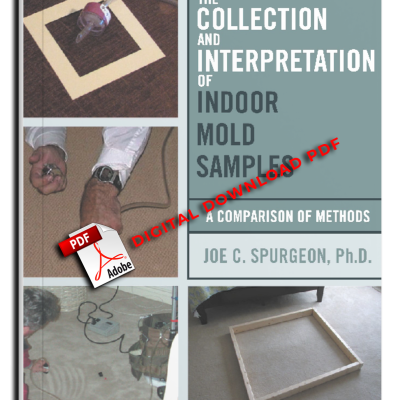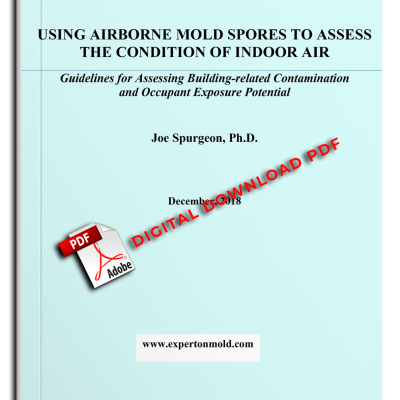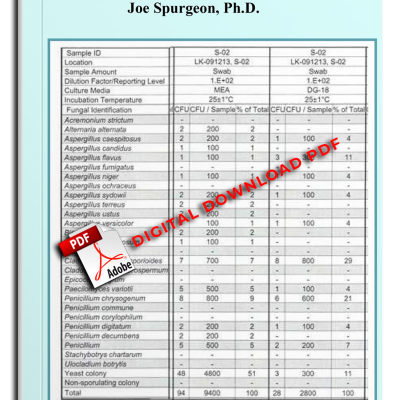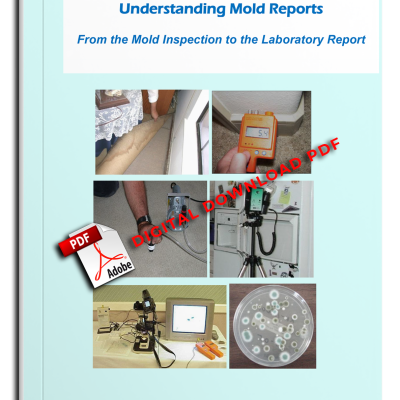The ERMI Test
The Environmental Relative Moldiness Index (ERMI) test requires the occupant to collect a sample of surface dust, probably using a sampling method recommended by a laboratory. The laboratory then analyzes the dust sample for 36 specific fungi and calculates an ERMI Score based on 26 Group 1 contaminant fungi and 10 Group 2 common environmental fungi. These were the 36 fungi that were commonly detected in carpet dust samples collected from more than a thousand homes using a specific vacuum sampling method. The samples were then analyzed by a laboratory using the same method that your laboratory used. Those results were reported as an ERMI score, essentially with values ranging from -10 to +20. If the Score is zero or less it is generally acceptable, and unacceptable if +5 or greater.
Collecting ERMI Samples
There are two broad objectives when assessing indoor mold, assessing Building-Related Contamination (BRC) and assessing Occupant Exposure Potential (OEP). Based on my experience most people collect ERMI samples because they (1) have concerns about their personal exposure to indoor mold, and (2) have been diagnosed with hypersensitivity to mold (CIRS, HERTSMI). Therefore, the objective is typically to assess OEP and not to assess BRC. However, whatever your objective, (1) understand what you are actually measuring when collecting an ERMI sample, and (2) make sure the ERMI result will support your and your physician’s objectives, needs, and requirements.
Everything begins with the collection of the sample. We have probably all heard the old adage “garbage in, garbage out”. The utility of the sample result, the ability of an Indoor Environmental Professional (IEP) to assist in the interpretation of that result, and the quality of a medical diagnosis that references the results are all directly affected by the collection of the sample. If the sample is not representative of the indoor environment that was sampled, then the reported result will provide little assistance in assessing the condition of that environment. In that case the time, money, and resources put into the endeavor will have been wasted. But worse, unless this situation is recognized, a false reliance may be placed on faulty results, potentially misleading the investigators.
The following factors should be considered when planning the collection of ERMI samples. The time spent preparing a simple Sampling Plan that includes their consideration can result in substantial benefits
1. Is there a standardized sampling protocol for home use?
ERMI Scores are based on a standardized sampling protocol that was developed by professionals. There is no standardized sampling protocol available for use by homeowners, although some laboratories do provide more detailed methods in their instructions than others. This means that your results are going to be more variable than the original ERMI data; and your Scores will be harder to compare to Scores from other people.
2. Can ERMI Scores be applied to samples other than carpet dust?
Not with as much reliability, so more “qualitative”. ERMI samples are commonly collected from a variety of surfaces, but ERMI was developed for carpet dust. Using the Scores for other surfaces is an extrapolation
without validating that extrapolation.
3. How does using a “Swiffer” duster or cloth to collect the sample affect the results? Can a dry Q-tip or gauze pad be used (teaspoon of dust in a Ziploc bag can be a goal)?
A Swiffer is designed to attract dust and mold particles, hold onto them, and to collect them. Now imagine the exact opposite task in the laboratory, which is to get those adhered mold spores off the Swiffer so they can be analyzed. I do not know the efficiency mold spores can be dislodged from an attractive surface like a Swiffer, but I would guess it is well less than 100%.
4. Sample visible mold; don’t sample visible mold? Sample water damaged areas; don’t sample water damage areas?
If these questions are at issue, then an IEP is needed. You should not be collecting an ERMI sample.
5. Where to sample? Living room/bedrooms; first/second floors; house, basement, garage; each HVAC zone?
I am going to define separate spaces in an indoor environment as Similar Exposure Areas (SEA). The occupant gets to actually define these spaces. Where do you/family spend most of your time? If it’s the living room and the bedrooms then sample those areas. If they are in different HVAC zones then sample them separately. Consider hard surfaces, soft surfaces, carpets, HVAC returns/filters, HVAC supplies, basements as separate SEA and do not sample multiple SEA in one sample; use a separate sample in each SEA but can sample multiple surfaces within an SEA.
6. What frequency to sample? One sample only, quarterly, each season, episodically?
There can be a substantial amount of variation in ERMI Scores between samples collected within minutes of each other from the same indoor environment. In addition, conditions change with time, seasons, and events. For example, those living in regions subject to wildfires can experience an impact to the indoor environment from mold spores due to a nearby wildfire. Plan on the sampling frequency. There are no preferences, just depends on the objectives and conditions.






